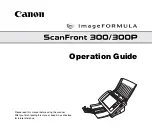
5
level, OR click on
Auto for automatic exposure control
Auto Reference: 60
Auto Max Value: 1/200 (Do not select Auto)
Highlight Reduction: (Seems to look better if you do not click on Enable)
Image
Sharpness: 0
Gamma: 70
Denoise: 0
Special
Trigger:
Enable
Software trigger: (not used)
Polarity (leave unchecked)
Delay: 15
s
GPIO (Section not used)
Strobe (Section not used)
WDR
(Wide Dynamic Range): (not used)
.
Effects:
(not used)
View:
Status Bar
Window:
(not used)
Help:
(If you need help about the program)
To
save
all these settings, go to
File: Save Configuration.
The software will pick a general location, you enter the
camera model, TVT-PHD model, or some other identifier. Click OK.
You can reduce the image size so the whole video frame will show on the monitor, for adjusting the
framing, or you can enlarge the image to check focus and grain. Use the + / - buttons at the top.
If a lot of image processing is being done, you might need to use a faster shutter speed of say 1/250, 1/500
or 1/1000 etc. to give the computer enough time to do it, especially above 25 FPS.
You will note that the automatic color and automatic exposure changes occur in discrete steps, unlike the
smoother looking changes of most analog cameras. To avoid this, stop running, do a manual change, and resume
the transfer from the start of the scene.
After You’ve Captured the Film
When finished you have an AVI file that defaults at 29.97 FPS where each video frame is an individual
film frame - no pulldown or blurred frames. If you play back the file in Windows Media Player or VLC, it'll
probably play back fast. You can either change the frame rate (typically to 18 FPS) in the header with a free
program like AVIFrameRate or AVIFrate, or change it in your video editing software.
When displayed on an HDTV monitor set to 16:9 the image will be stretched. To fix this without video
editing requires the viewer to change his HDTV’s setting to 4:3, which is a bit of a nuisance and the procedure may
have been forgotten. To fill the 16:9 frame with an image, making it more convenient for the viewer, you could
crop the image or stretch the frame, with loss of information, resolution or natural proportions. Or, preferably you
can insert “pillarbox” black bars, blurred versions of the central image, or some sort of wallpaper, on the left and
right sides so the HDTV can be left at the accustomed 16:9 ratio with no film detail lost or mangled.
Other Information
Footage Count:
The TVT-8PHD C does not have footage or running time counters. Generally the
original length of the film is not much of an issue with digital capture since the material will be edited down.
However the length can be computed from the frame count in the file’s Properties divided by the following
number: Super-8 film is 72 frames per foot and regular-8 is 80 frames per foot. For metric system fanciers, this is
262.47 frames per meter of regular-8 and 236.22 frames per meter of super-8.
Routine service:
After long use, the cams and other parts may need greasing. Refer to your authorized Chinon, Keystone or
Bell & Howell service provider for lubrication. The factory recommended lubricant should be applied to the cams
and followers. You may want to have applied a drop of light turbine oil to each bearing on the shutter and motor

























